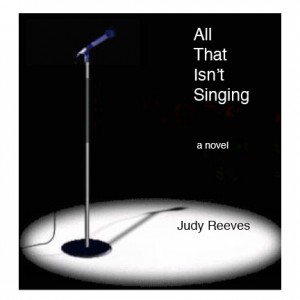So, in Oprah’s words, “here we go …”
What is the working title of your book?
All That Isn’t Singing
Here’s a book jacket I created and pinned to the bulletin board above my writing desk.

Where did the idea come from for the book?
In my previous (unpublished) novel, Louise, the 17-year-old daughter of the protagonist, ran away from home to become a singer. After I went as far as I could go with that novel and put it in the drawer, Louise wouldn’t leave me alone. Just like a teenager, she kept pestering me until I couldn’t ignore her. She wanted me to come to Kansas City with her, so that’s where we are: Kansas City, 1957-58.
What genre does your book fall under?
For a while I thought it might be literary fiction, but it didn’t come out that way. It’s not mainstream or commercial fiction either. I’ve heard the term “upmarket fiction” bandied about lately. That’s what I’ll label mine.
Which actors would you choose to play your characters in a movie rendition?
Louise: too bad Gwyneth Paltrow can’t play an 18-year-old and Miley Cyrus can’t act. I bet Nicole Kidman could have rocked this role if I’d written the book years ago. Sarita, Louise’s Cuban-American best friend: Would it be too much to ask to have Penelope Cruz as Sarita? Love to see Leonardo DiCaprio as blind disc jockey and music impresario Johnny Midnight. Roman, Louise’s boyfriend: Zac Efron, young, sexy and he can play the guitar. I’ve always seen Bonnie Raitt as Louise’s first idol, Ruby Diamond, but I don’t think Bonnie takes movie roles.
What is the one-sentence synopsis of your book?
Oh, if you only knew how many one sentences I have attempted to get a concise synopsis of this book. Here’s the latest: When seventeen-year-old Louise Guest runs away from her home in rural Missouri to pursue her singing career in Kansas City, she discovers what her idol, Ruby Diamond told her is true: “Anyone can be a success, honey. You just have to be willing to give up everything for it.”
How long did it take you to write the first draft of your manuscript?
Probably a couple of years to get to the end of the first draft. In this novel and the previous one, I wrote in fragmented scenes and chapters, looking for the story and developing the characters. I tell my students that I write 1000 words to get 100. I figure that same ratio applies when writing scenes and chapters. I also do quite a lot of writing “outside the story,” that is, exploring in a notebook character histories and background; I draw maps of settings and do necessary research. For example, in this book, I had to learn about Cuban history and the Cuban Revolution and do a lot of music research.
Who or what inspired you to write this book?
I don’t know if the fact that Louise wouldn’t leave me alone could be called inspiration, but there was no way she was going to go away. Also Ruby Diamond was in the first novel and I loved everything about Ruby Diamond and wanted to spend more time with her. The novel is also a coming-of-age story and Louise’s transition from naïve teenager to a young woman who must assume responsibility for herself and her choices is something I care about.
What else about your book might pique the reader’s interest?
The era—the end of the fifties. We seem to be experiencing fascination with what has come to be called “mid-century” though it makes me feel awfully old to use that term. Someone told me I should include a CD of the soundtrack with every novel. Louise is a singer and she moves through popular music and rock and roll to jazz, with a touch of country, due to Ruby Diamond’s influence. Beat poetry and literature are influences, also, as I mentioned, the Cuban Revolution plays in the story. The Cold War, school integration and the beginning of the civil rights movement are all part of the background for Louise’s personal story.
Thanks, Midge, for inviting me to play and for anyone in the San Diego area mid-January, Midge will present an Everyday Writing workshop on January 12 at the Lively Muse Studio.


This post has inspired me to write my own post about my recently completed children’s picture book, Tommy’s Tee Shirt. I am looking forward to reading about Louise, too.
Thanks for commenting, Diana and glad to hear you’re writing a post about your own “Next Best Thing.” Congratulations on completing “Tommy’s Tee Shirt.”
This is wonderful, Judy. I think that a great one-line synopsis, one that should make anyone want to read the book. I’m hoping that the next time I see you, you’ll tell me what upmarket fiction fiction is. Good job! xb
Thanks for commenting, Bonnie, and thanks for the thumbs up on the one-liner. From what I understand, upmarket fiction lands somewhere between literary and commercial/main stream. The writing leans toward the literary side, and the story is one that appeals to a more “commercial” reader. I think.
Sounds great! Can’t wait to read it. Love to hear how Louise wouldn’t leave you alone. Jane, the MC in my WIP, did the same thing to me! 🙂
Hi Jackie,
Sure does feel better knowing other writers have the same experience. When so much about the process is weird to nonwriters, it’s good to hear from someone who speaks the same language. Does Jane show up in your dreams, too? Louise has from time to time. Thanks for posting.
Judy, I can’t wait to read your Next Best Thing! Thanks for playing. 🙂
Thanks for inviting me, Midge. Now let’s go and finish our books.